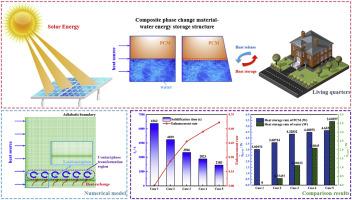石蜡与水相变混合物放热性能的数值研究
IF 6.3
2区 材料科学
Q2 ENERGY & FUELS
引用次数: 0
摘要
根据水和石蜡的不相容性以及水的高导热性,构建了一种新型相变储能结构。该结构底部填充水,顶部填充相变材料。通过数值方法利用水开发了接触相变区,并研究了不同底部水量对整个储能装置放热过程的影响。结果表明,纯 PCM 单元在放热中后期可以忽略自然对流的存在,在凝固末期存在耐火区。增加底部水量有利于水和石蜡的结合,从而加速石蜡的凝固。这种调整也会使热源吸热处的冷量继续增加,从而使整体水温下降更快,对石蜡的传热效果更加突出。在工况 3 和工况 5 中,当水的高度分别为 5.0 毫米和 10.0 毫米时,凝固时间比工况 1 分别缩短了 46.57 % 和 66.67 %。此外,与情况 1 相比,情况 3 和情况 5 的总放热量分别减少了 4.27 % 和 9.56 %,表明总热能的减少量相对较小。进一步的梯度结构设计表明,正梯度结构有利于提高装置的平均放热率和缩短装置的凝固时间。本文章由计算机程序翻译,如有差异,请以英文原文为准。

Numerical investigations on heat release performance of phase change mixture of paraffin and water
Based on the incompatibility of water and paraffin and the high thermal conductivity of water, a novel phase change energy storage structure is constructed. The structure is filled with water at the bottom and phase change material at the top. The contact phase transition region is developed using water by numerical method, and the influence of different bottom water volumes on the heat release process of the whole energy storage unit is studied. The results show that the pure PCM unit can ignore the existence of natural convection in the middle and late stages of heat release, and there is a refractory zone at the end of solidification. Increasing the amount of water at the bottom is conducive to the combination of water and paraffin, thus accelerating the solidification of paraffin. This adjustment also causes the cold capacity at the heat source absorption to continue to increase, resulting in a faster drop in the overall water temperature and a more prominent heat transfer effect on paraffin. In Case 3 and Case 5, when the water height is 5.0 mm and 10.0 mm, the solidification time is shortened by 46.57 % and 66.67 %, respectively, compared with Case 1. In addition, the total heat release in Case 3 and Case 5 is reduced by 4.27 % and 9.56 %, respectively, compared with Case 1, indicating that the reduction in total heat energy is relatively small. The further gradient structure design shows that the positive gradient structure is beneficial in increasing the average heat release rate of the unit and reducing the solidification time of the unit.
求助全文
通过发布文献求助,成功后即可免费获取论文全文。
去求助
来源期刊

Solar Energy Materials and Solar Cells
工程技术-材料科学:综合
CiteScore
12.60
自引率
11.60%
发文量
513
审稿时长
47 days
期刊介绍:
Solar Energy Materials & Solar Cells is intended as a vehicle for the dissemination of research results on materials science and technology related to photovoltaic, photothermal and photoelectrochemical solar energy conversion. Materials science is taken in the broadest possible sense and encompasses physics, chemistry, optics, materials fabrication and analysis for all types of materials.
 求助内容:
求助内容: 应助结果提醒方式:
应助结果提醒方式:


